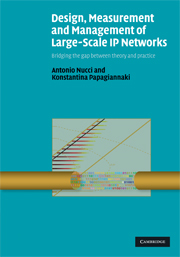 Design, Measurement and Management of Large-Scale IP Networks
Design, Measurement and Management of Large-Scale IP Networks from I - Network monitoring and management
Published online by Cambridge University Press: 05 September 2012
The traffic matrix (TM) of a telecommunications network measures the total amount of traffic entering the network from any ingress point and destined to any egress point. The knowledge captured in the TM constitutes an essential input for optimal network design, traffic engineering and capacity planning. Despite its importance, however, the TM for an IP network is a quantity that has remained elusive to capture via direct measurement. The reasons for this are multiple. First, the computation of the TM requires the collection of flow statistics across the entire edge of the network, which may not be supported by all the network elements. Second, these statistics need to be shipped to a central location for appropriate processing. The shipping costs, coupled with the frequency with which such data would be shipped, translate to communications overhead, while the processing cost at the central location translates to computational overhead. Lastly, given the granularity at which flow statistics are collected with today's technology on a router, the construction of the TM requires explicit information on the state of the routing protocols, as well as the configuration of the network elements. The storage overhead at the central location thus includes routing state and configuration information. It has been widely believed that these overheads would be so significant as to render computation of backbone TMs, through measurement alone, not viable using today's flow monitors.
To save this book to your Kindle, first ensure [email protected] is added to your Approved Personal Document E-mail List under your Personal Document Settings on the Manage Your Content and Devices page of your Amazon account. Then enter the ‘name’ part of your Kindle email address below. Find out more about saving to your Kindle.
Note you can select to save to either the @free.kindle.com or @kindle.com variations. ‘@free.kindle.com’ emails are free but can only be saved to your device when it is connected to wi-fi. ‘@kindle.com’ emails can be delivered even when you are not connected to wi-fi, but note that service fees apply.
Find out more about the Kindle Personal Document Service.
To save content items to your account, please confirm that you agree to abide by our usage policies. If this is the first time you use this feature, you will be asked to authorise Cambridge Core to connect with your account. Find out more about saving content to Dropbox.
To save content items to your account, please confirm that you agree to abide by our usage policies. If this is the first time you use this feature, you will be asked to authorise Cambridge Core to connect with your account. Find out more about saving content to Google Drive.